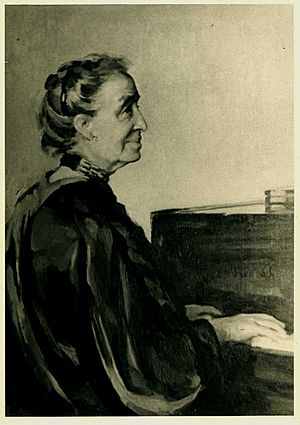Eugénie-Emilie Juliette Folville facts for kids
Quick facts for kids
Eugénie-Emilie Juliette Folville
|
|
|---|---|
 |
|
| Background information | |
| Born | January 5, 1870 Liège, Belgium |
| Died | 28 October 1946 (aged 76) |
| Occupation(s) | Pianist, Violinist |
Eugénie-Emilie Juliette Folville (born January 5, 1870 – died October 28, 1946) was a talented Belgian musician. She was a pianist, violinist, music teacher, conductor, and composer. She created many different kinds of music during her life.
Contents
A Musician's Life
Juliette Folville was born in Liège, Belgium. She started learning music from her father, who loved music even though he was a lawyer. She became very good at playing the violin. She studied with famous teachers like Charles Malherbe, Ovide Musin, and César Thomson.
Juliette first performed in public in Liège in 1879. She was only nine years old! She had a very successful career playing concerts. In 1897, she began teaching piano at the Royal Conservatory of Liège. This is a special school for music.
She lived in London for several years. During World War II, she lived and performed in Bournemouth, a town in England. Juliette Folville passed away in Dourgne, France, on October 28, 1946.
Her Musical Works
Juliette Folville wrote music for many different things. She composed for plays, for solo instruments, for orchestras, for choirs, and for small groups of instruments.
Music for Orchestra
An orchestra is a large group of musicians playing many different instruments together. Juliette wrote several pieces for orchestras, often called "suites." A suite is a collection of musical pieces.
- Scènes champêtres (Country Scenes), op. 9 (1885): This suite has parts like "In the Fields" and "Village Festival."
- Scènes de la mer (Sea Scenes), op. 14 (1886): This suite includes pieces like "Fisherman's Song" and "Starry Night."
- Scènes d'hiver (Winter Scenes), op. 17 (1887): This suite features parts like "Ballad" and "Carnival."
- Violin Concerto in G Minor, op. 20 (1888): A concerto is a piece for a solo instrument (like a violin) with an orchestra.
- Piano Concerto in D Minor (1902–1903): A concerto for a solo piano and orchestra.
- Concerstück for cello and orchestra (1905): A single piece for cello and orchestra.
- Impressions d'Ardenne, orchestral suite (1910): Music inspired by the Ardenne region.
- Triptyque for violin and orchestra, or piano (around 1935): A three-part piece for violin with either an orchestra or piano.
Music for Small Groups and Piano
Juliette also wrote music for smaller groups of instruments, called "chamber music," and for solo piano.
- Souvenir de Mozart. 1re Sonatine (op. 7, 1881) and 2e Sonatine (op. 11, 1882): Short, simple sonatas, like a musical "hello" to Mozart.
- Berceuse for violin and piano, op. 24 (1890): A lullaby-like piece for violin and piano.
- En Ardenne. Esquisses pour piano (around 1910): Piano sketches inspired by the Ardenne region.
- 1er Quatuor pour piano, op. 9 (1885): A quartet for piano and three other instruments.
- Berceuse for cello and quartet accompaniment (date unknown): A lullaby for cello with a small group of instruments.
- Poème for cello and piano, or orchestra (around 1908-1909): A poetic piece for cello.
- Mazurka for violin and piano (1910): A lively dance piece.
- Communion for organ: A piece for the organ.
Music for Choirs and Singers
Juliette also wrote music for choirs (groups of singers) and solo singers.
- Chants printaniers (Spring Songs) (1883–84)
- Atala. Drame lyrique en deux actes (1891): An opera, which is a play set to music, with words by Paul Collin. It was first performed in Lille in 1892.
- Ewa. Légende Norwégienne (Norwegian Legend), cantata (around 1889): A cantata is a piece for singers and orchestra, based on a poem by Paul Collin.
- Noce au Village (Village Wedding), op. 13 (1886): For solo singers, choir, and orchestra, with words by Paul Collin.
- Jean de Chimay. Drame lyrique en quatre actes: An unfinished opera.

